
Digital sustainability and the choir of many voices
Our appetite for digital content is voracious. But Digital infrastructure brings with it an environmental and social footprint.
Summary: Digital sustainability is an important issue that requires a multi-faceted approach to address the complex challenges posed by the growth of digital technology. Solutions and approaches need to encompass a number of areas including data centres, interfaces (websites and apps), connection (data transmission) and the devices that use to consume data and content (TV, mobile devices, computers etc). We also look at e-waste and social considerations briefly.
Why this is important: Sometimes our human activities are big and obvious - industrial processes need heat and pressure, from burning of fossil fuels, and emit greenhouse gases as byproducts. Sometimes they're small and not so obvious - streaming content from the cloud. Understanding the impact of activities can influence design, policy and marginal consumption choices.
The big theme: Greenhouse gases emitted by human activity are impacting the amount of heat that escapes our atmosphere and driving global warming. Atmospheric concentrations of carbon dioxide (CO2), methane (CH4), and nitrous oxide (NO2) have increased by more than 40, 150 and almost 20 percent respectively since pre-industrial revolution times. Over half of the CO2 rise has happened since 1970.

The details
Where I grew up, EVERYONE supported West Ham United. Not really that much of a surprise as their training ground was very close to where we lived. The football team that you end up supporting can be driven by a number of factors from the hereditary (your parents supported that team and hence you do) to the geographical (they are physically your local team) to the populist (they are currently doing well or are the most popular).
For me it was just about being different.
Arsenal were a rival London team and I really liked their blue and yellow away kit. Of course it was then helped by the last minute winner in the 1979 FA Cup final by Alan Sunderland against Man Utd. I was from that point on a Gooner.
The thing that always struck me most, and still does about live football and many other sports is the noise of the ground. Sometimes it is grunting and groaning, sometimes it is chanting and then, particularly in football, it is singing.
An individual fan only makes so much noise, but put tens of thousands of them together and they make quite the impact. A choir of many voices.
The digital world has a similar aspect.
In Mike Berners-Lee’s book, "How Bad are Bananas?: The Carbon Footprint of Everything", there is a statement that an individual watching TV for a year has a similar carbon footprint to driving a car for 500 miles.
500 miles is a daily working return commute of only 2 miles per day. In CO2 equivalent terms that is just over 200kg of CO2 in a year. That is not that big when compared with the approximately 2.2 tonnes of CO2 that the average UK household gas boiler produces heating a home for year.
The impact of an individual watching TV for a year is small. But when you add up all of the TV watching across the globe, it makes a meaningful impact.
Digital technology has revolutionised the way we live and work, enabling us to connect with people from around the world, access vast amounts of information, and streamline many aspects of our daily lives. However, the growth of digital technology has also brought with it concerns about its impact on the environment and the sustainability of our digital infrastructure.
When many individuals are doing a small impact activity, that can soon add up to something meaningful.
The Shift Project estimated in 2019 that 'Digital' accounted for more than 3.5 percent of global GHG emissions, but there is a risk that it could be closer to eight percent by 2025.
Cisco predicted in 2020 that the total number of Internet users this year will reach 5.3 bn - that's six percent growth on average every year since 2018. According to Sandvine global Internet traffic was up 23 percent in 2022 driven by an upsurge in streaming video in particular which grew 24 percent.
That's where a focus on digital sustainability is important and can be impactful in a good way.
Digital sustainability
Digital sustainability refers to the responsible use of digital technology to minimise its negative impact on the environment and promote sustainable practices.
Digital infrastructure is a big area. For the sake of brevity I shall simplify into four main areas that are involved in us accessing and viewing content:
- Data centres: a facility that centralises the storage, processing and disseminating of data.
- Interface: websites and mobile apps that we use to select the content we want to consume.
- Connection: transferring data, typically broadband internet access that is either wireless or wired that carries the data/content to our devices.
- Device: what we use to consume content - mobile devices, computers and TV.
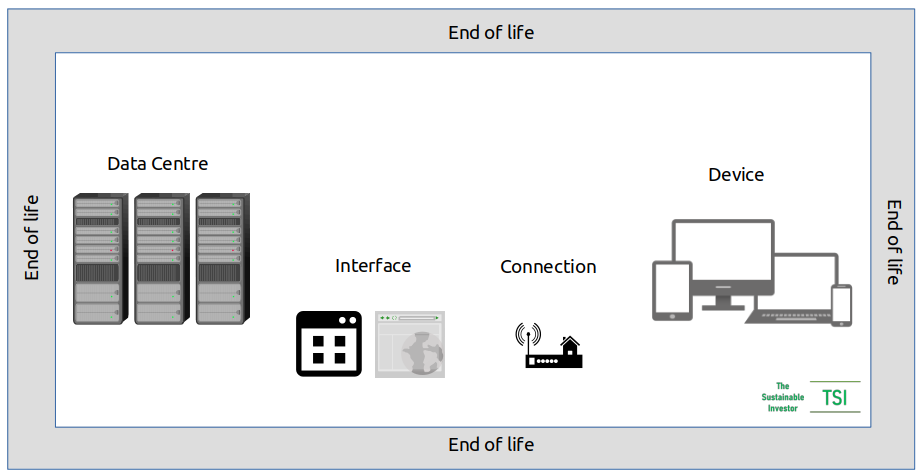
When we as individuals use digital infrastructure some of the footprint is not right in front of us. We need to also consider the 'scope 3' emissions.
That includes emissions from the supporting infrastructure as well as embodied carbon of devices, that is the emissions generated in taking the raw materials and manufacturing them into a device for sale to the consumer. Emissions that are a direct and indirect result of that consumption.
There is an environmental impact whilst using digital infrastructure, but also once the equipment involved has reached the end of its useful life.
We shall look at each of these areas in turn.
Data Centres
Data centres house the servers (computers) and other equipment to process and store the data that ultimate becomes the content that we view. They are quite energy-intensive by nature and their own environmental impact is driven by how much energy they consume, how much heat is generated from their operations that needs to be dissipated somehow, and how that energy is generated.
There are a number of initiatives aimed at reducing their energy consumption.
A well known law in semiconductor development is the so-called 'Moore's Law' which observed that the number of transistors in a microchip doubles every two years, whilst its cost halves. This has led to computers becoming smaller and faster.
However a similar phenomenon has been observed in terms of the amount of energy required for a chip to do a certain number of computations. 'Koomey's law' describes a remarkable improvement in energy efficiency, finding that since 2000, the number of computations per joule of energy (1 kWh = 3.6 million joules) has doubled every 2.6 years on average.
This has been facilitated through chip design creating low-power processors, the use of solid state drives for storage rather than hard disk drives (which have moving parts and consume much more power) and server virtualisation.
Server virtualisation is the process of dividing a physical server into multiple unique and isolated virtual servers using a software application. Each virtual server can run its own operating systems independently. This improves the utilisation of the physical server.
All of these different initiatives are helping data centres to keep apace with or really stay ahead of the growing voracious demand. The chart below is indexed to 2015 figures (100).
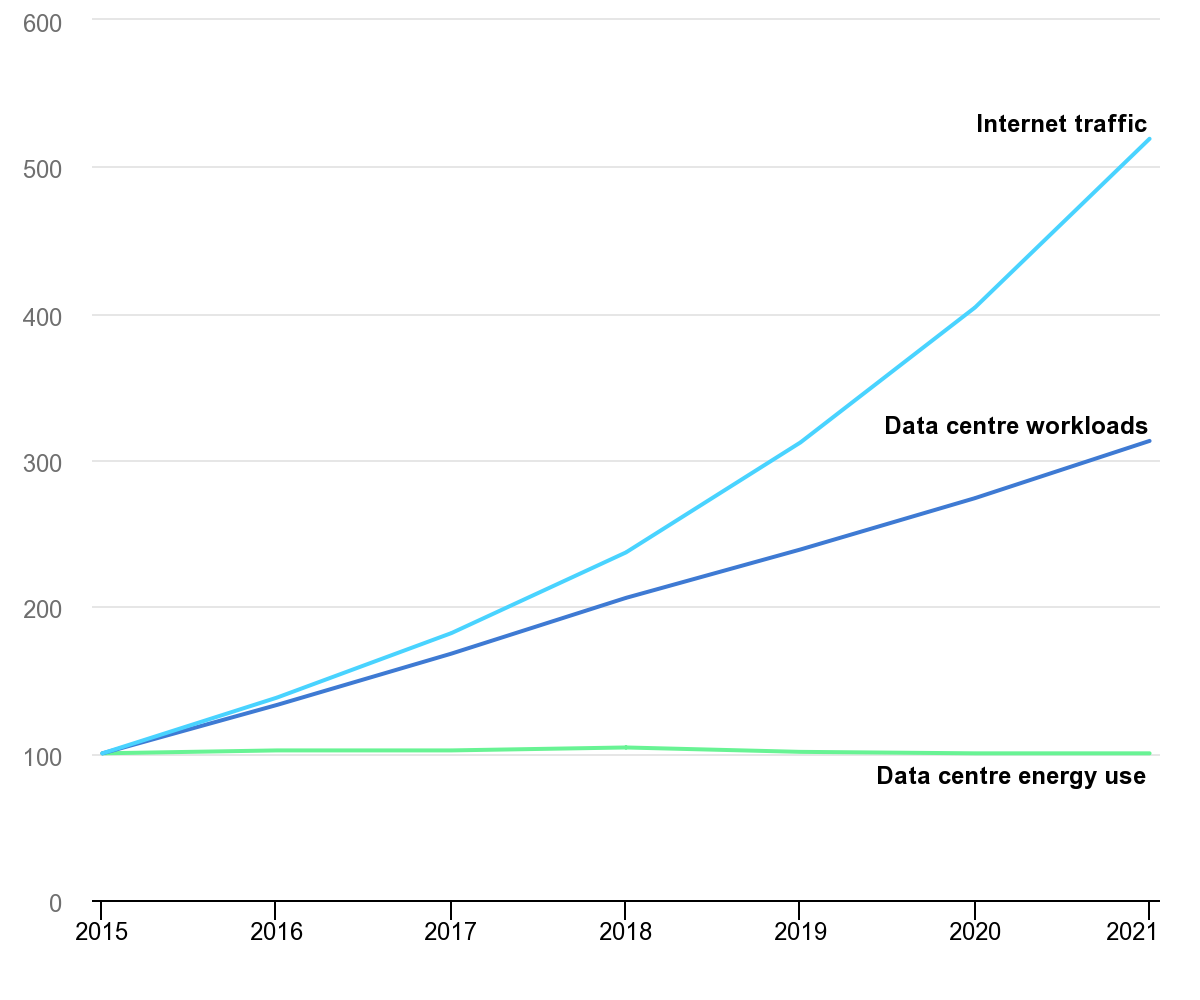
One important aspect of efficiency is cooling. As much as 40 percent of the power running through a data centre is used for cooling.
When servers are running they generate a lot of heat. The amount of heat generated can be impacted by the chip design, the physical server design, the layout of the many servers in the data centre and of course how much they are being used.
There are a number of different methods for cooling from Computer Room Air Conditoners ('CRAC's) to Computer Room Air Handlers ('CRAH's) which are essentially CRACs that have chilled water to cool external air that circulates. Other methods include evaporative cooling and raised floor cooling, although the latter is being used less. In most of these cases cool water takes away the heat generated.
Historically that heat was lost, but increasingly data centres are finding ways to reuse that heat.
For example, Swedish EcoDataCenter and circular industry player WA3RM are collaborating to use waste heat for large-scale cultivation.
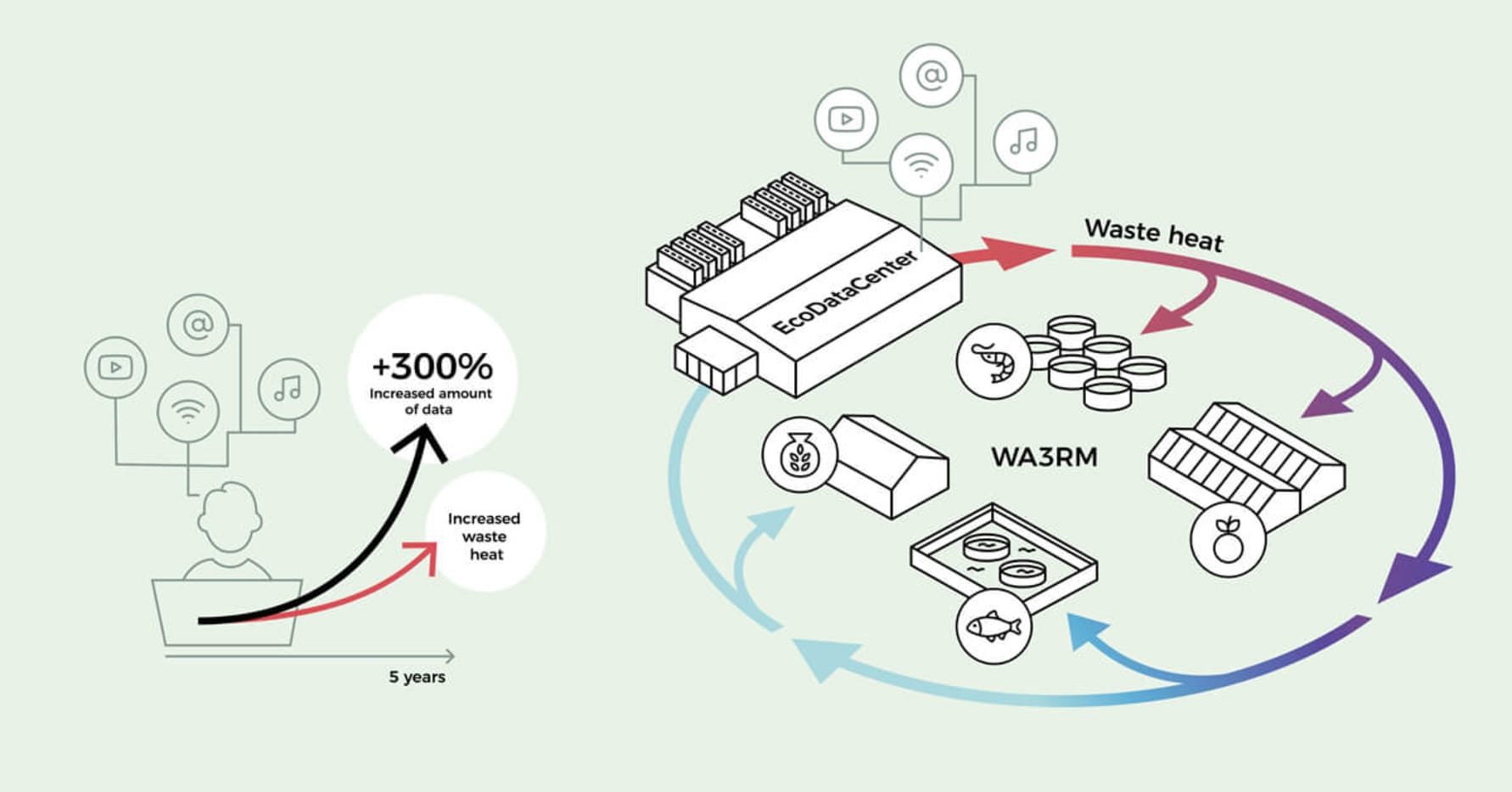
There are many examples of this globally. In France Equinix has opened an urban rooftop farm on its PA10 data centre in Paris. Waste heat from its servers warms the greenhouses. In Japan, White Data Center has been using waste heat to farm eels and grow mushrooms.
Deep Green in the UK deployed its AI-based digital boiler heat recapture technology at a leisure centre in Exmouth, Devon to reduce the site's gas requirements by 62%, cut the site's CO2 emissions by 25.8 mt and save its owners more than £20,000 a year in energy costs. Deep Green's system comprises 12 servers running AI, machine learning and video rendering workloads, which capture waste heat using immersion-cooling and transfer it to the centre's hot water system.
Tomorrow Water have integrated a waste water treatment plant (WWTP) and a data centre on a single plot of land. Tomorrow Water relies on its Proteus+BBF Biofiltration system, which is a single up-flow reactor combining physical filtration with biological treatment, to substantially reduce the size of WWTPs and enable them to be significantly smaller.
Under their Co-Flow concept, treated water will be used to cool data centres via heat-exchange. The cooling process generates hot air that is diverted back into the WWTP’s treatment systems and used to warm biological reactors for renewable biogas production.
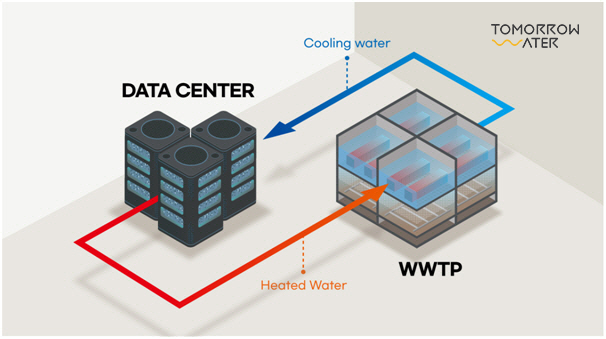
This could be an important solution, in part at least, to another big environmental impact of data centres: water consumption. Google's data centres around the globe used over four bn gallons of water or more than 15 bn litres in 2021. More than 80 percent of that was in the US.
Beyond data centres, wastewater can provide us with heat (for our buildings) plus raw materials for fertiliser and for energy. We explore that more broadly in this blog 👇🏾
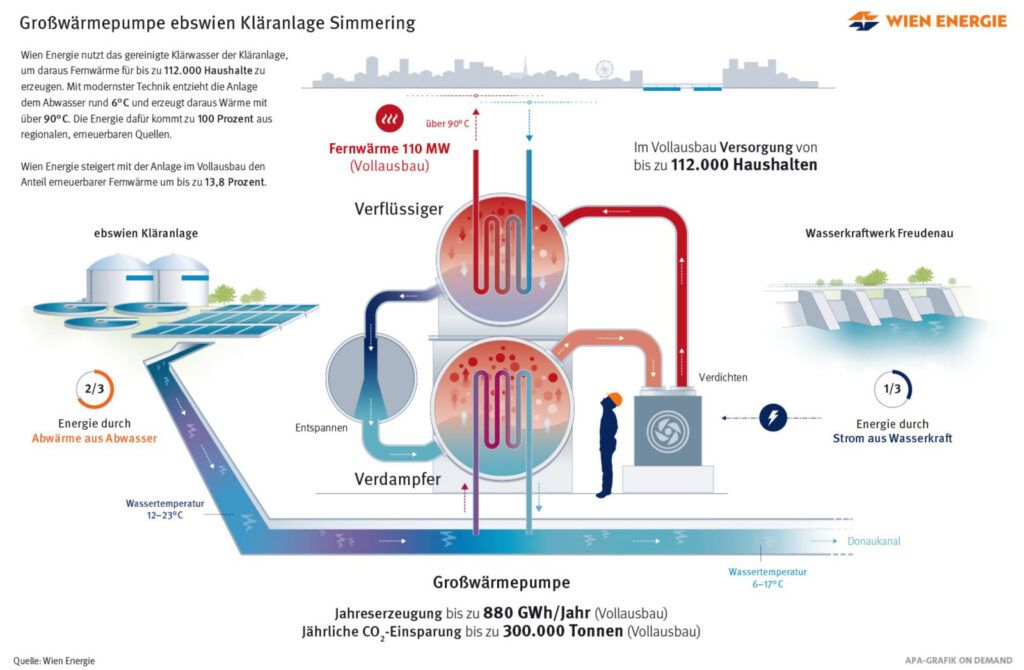
Of course, a major way to reduce the carbon footprint of a data centre is to use low carbon methods to generate the energy they consume.
The lowest carbon method is to not use energy at all! For cooling that can be achieved by locating data centres in cold locations. The White Data Centre that we mentioned earlier uses snow collected from streets in Bibai from the heavy snowfalls their each winter to cool their servers and networking equipment.
Another approach is to encourage the use of renewable energy sources, such as solar or wind power, to power digital infrastructure.
Companies like Google, Apple, and Facebook have committed to using 100% renewable energy for their data centres, and other companies are following suit.
Amazon, for example, added 71 new renewable energy generation projects to its portfolio in the back end of 2022 bringing their total to 379 projects with a total capacity of 18.5 GW. In 2021 Amazon was the largest purchaser globally of clean energy bying 44 offsite power purchase agreements amounting to 6.2 GW.
So through a number of innovations, the carbon and water footprints of data centres can be reduced (and are being reduced) as well as recycling waste elements, particularly heat.
Interfaces
What I am referring to here are the mobile apps and websites that we access to select the content that we are going to view.
Website sustainability is the practice of designing, building, and maintaining websites in a way that minimises their negative impact on the environment and promotes sustainable practices.
Websites are hosted on servers that consume a significant amount of energy (as we have already discussed), and this energy consumption is driven by the demands of the website itself.
Websites are a significant part of our digital infrastructure, and there are several ways in which they can be made more sustainable. Here are some high level areas for optimising energy consumption:
- Coding: this includes minimising the use of large images, videos, and other media files that can slow down the website and consume more energy. At a broader level sustainable web development practices, include using open-source software and platforms, which are developed and maintained by a community of developers and are available to everyone for free. This can significantly reduce the environmental impact of website development by reducing the need for proprietary software and reducing the amount of coding required.
- Design: this includes using a minimalist design approach that focuses on simplicity and functionality, which can reduce the amount of data that needs to be transmitted and the energy required to load the website.
- Content Delivery Networks (CDN): A CDN is a network of servers located around the world that cache website content and deliver it to users based on their geographic location. By using a CDN, website owners can reduce the distance that data has to travel, which can significantly reduce energy consumption.
- Web hosting: there are sustainable web hosting providers that prioritise sustainability in their operations. This includes providers that use energy-efficient servers, use renewable energy sources, and offset their carbon emissions through carbon credits or other means. Although as we discussed previously that is becoming less of a distinction as the industry as a whole improves.
- Sustainable marketing: this includes using digital marketing techniques that are designed to be less intrusive and more targeted, such as email marketing and social media marketing. Whilst individually small, reducing the number of emails and posts reduces the impact on the receivers side too. In addition they can replace traditional paper-based advertising and direct mail marketing and their associated footprints.
It is such a big area in its own right that we shall be exploring it in more detail in a forthcoming Perspective.
Connection
How data gets from a data centre through the interface and to our homes to view on a device will also have a footprint, both during use and at end of life.
Data transmission can be done through various means: wireless communication, satellite communication, and through fibre-optic cables.
One way in which the amount of data transmitted can be reduced is through video compression. This is a process that reduces the size of digital video files by removing redundant or irrelevant information while retaining the essential visual content.
There are two main types of video compression: 'lossless' and 'lossy'.
Lossless compression algorithms compress the video file without sacrificing any visual quality. These algorithms work by identifying and removing redundant data from the video file. The resulting compressed file is smaller in size but contains all of the original data. Lossless compression is often used in professional video editing applications where preserving the original quality of the video is critical.
On the other hand, lossy compression algorithms selectively remove data from the video file that is less visible to the human eye. Lossy compression algorithms are used for video streaming services and social media platforms.
Within our homes, there will be networking equipment including modems (that convert signals from digital to analogue) and routers (that help to connect many devices to a network either through cables or wirelessly) that will ultimately reach end of life and end up as waste (more on that later).
Devices
The device that we choose to view content on will have an environmental footprint.
Analysis by the International Energy Agency estimates that almost three-quarters of the energy use in viewing streaming video content is accounted for by the devices we use to view it. Data transmission accounts for around 23 percent and data centres 5 percent.
Operational CO2e emissions vary from device to device essentially correlated with their power consumption.
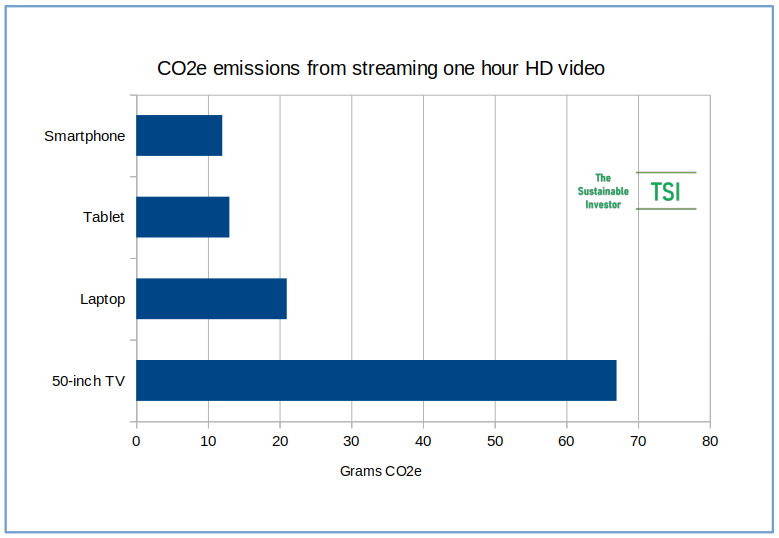
We discussed earlier how innovation in semiconductor design and manufacture has led to increasingly more efficient components. Low power processors are particular useful in mobile devices.
However, the majority of the footprint is in the embodied carbon of the devices being used to consume the content.
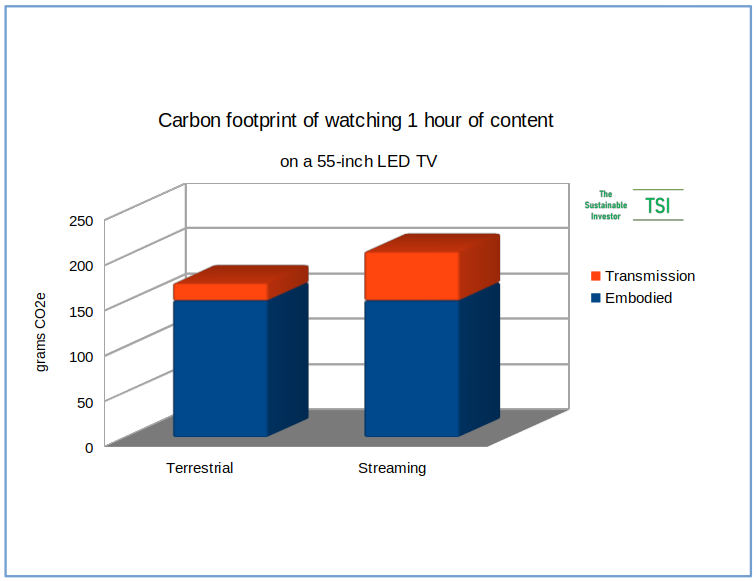
As a rule of thumb, all else being equal, the bigger the device, the bigger the embodied carbon.
Do we really need such big devices to watch our content? I do some analysis on optimal screen sizes here 👇🏾
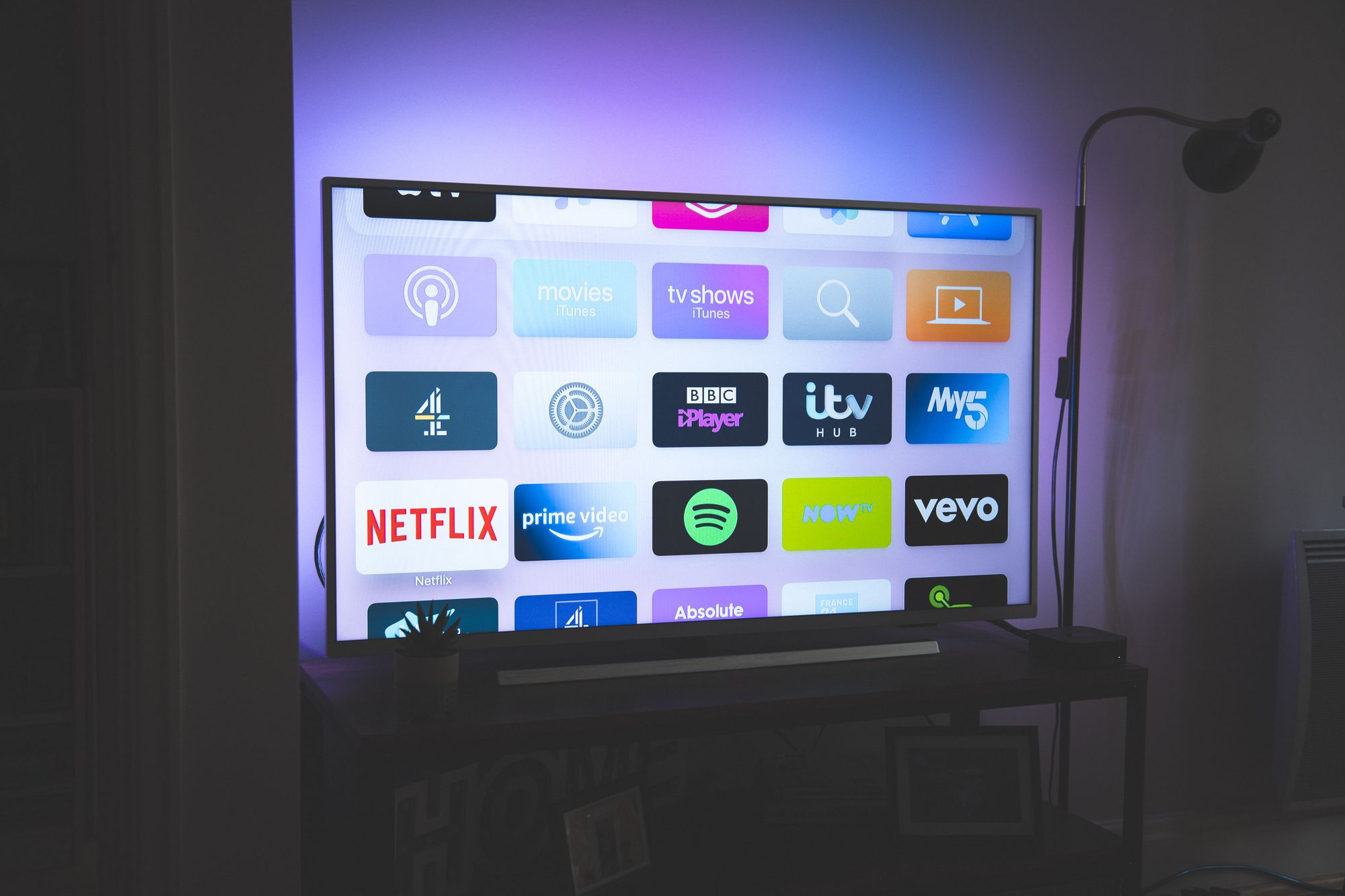
Worth noting that global TV shipments showed positive unit growth in only three of the past ten years (2014, 2016 and 2018). Are viewing habits changing from the big screen to mobile devices such as laptops, tablets or mobile phones?
Electronic waste
We have discussed the energy and resource consumption and hence environmental footprint of digital infrastructure whilst it is in use. But it is also important to consider what happens at the end of its useful life. That is important for the devices we watch content on but also equipment in data centres and the modems and networking devices for connecting to the Internet.
The rapid turnover of digital devices, coupled with the lack of proper disposal and recycling methods, has resulted in a growing amount of 'e-waste' that ends up in landfills or is shipped to developing countries for disposal. This can result in environmental pollution and health risks for local communities.
After China and the US, India is the the third-largest producer of E-waste but they have also developed a strong e-waste recycling industry. Companies include TES-AMM, Gujarat Green Recycling and Cosmos Recycling.
However, there are other initiatives that can promote a more circular economy where products and materials are designed to be reused, repaired, or recycled, rather than being disposed of after a short period of use.
This approach includes initiatives such as electronic take-back programs (e.g. Apple's), where consumers can return their old devices for recycling or refurbishment, as well as the development of modular and upgradable devices that can be easily repaired or upgraded rather than replaced.
Fairphone is a great example of this. As they say:
"You don’t need to be an expert to swap out the battery or display. No part of Fairphone 4 is glued shut, so you can choose to easily repair it yourself with a standard screwdriver."
Klyk is another example in the UK providing amongst other things refurbished devices to businesses.
Another factor is device lifespan. Here is the mobile phone I had before my current one. It is an iPhone 6. Most operators would have you believe that you need to change your phone every couple of years. I had my iPhone 6 for just over six years. The only reason I changed it was the phone's hardware could no longer take the new iOS upgrade.

It lasted so long for two main reasons. I kept it in a protective case (you can see the 'circle' around the logo from where the gap was in the case) and I changed out the battery for £40. That also ties back to the modularity and right to repair of a device. New battery was almost like getting a new phone. There is a mindset thing there too. Our devices last longer than we think. Some would argue that the Nokia 3310 lasts thousands of years ;-)
E-waste can be digital too! It is important to consider the end-of-life of a website when thinking about website sustainability. When a website is no longer needed, it should be properly decommissioned and recycled. This includes deleting all data from the website, cancelling any hosting or domain registration services, and properly disposing of any electronic equipment that was used in the development or hosting of the website.
Social considerations
In addition to environmental concerns, digital sustainability also encompasses social and economic issues. The growth of digital technology has brought about significant changes in the way we work, communicate, and consume information, but it has also resulted in concerns around privacy, data security, and social inequality.
For example, the increasing reliance on digital technologies for work and education has highlighted the digital divide between those who have access to reliable and high-speed internet and those who do not, creating disparities in educational and employment opportunities.
The collection and use of personal data by digital companies has also raised concerns around privacy and data protection, leading to calls for greater transparency and regulation.
To address these social and economic concerns, there are initiatives aimed at promoting digital literacy and access, as well as increasing transparency and accountability around data privacy and security.
We briefly introduced open source software previously. This is one example of getting digital tools into people's hands at low to zero cost.
Of course digital has a positive social equality impact as demonstrated during the pandemic and the move to remote working.
According to research by the Work Foundation think-tank at Lancaster University, workers with disabilities in the UK benefit from working remotely. The study surveyed 406 disabled employees and found many thought it was positive to have autonomy and control over their working environments to complete their tasks. Over 80 percent said remote working was essential when looking for a new role, and 66 percent would like to work from home between 80 and 100 percent of the time. However, 70 percent of those with two or more impairments worry that working from home may mean they get overlooked for career development opportunities.
Conclusion
In conclusion, digital sustainability is an important issue that requires a multi-faceted approach to address the complex challenges posed by the growth of digital technology.
By promoting energy-efficient devices and infrastructure, circular economy approaches to e-waste, and promoting digital literacy and access, we can ensure that digital technology is used in a responsible and sustainable manner that benefits both people and the planet.
Something a little more bespoke?
Get in touch if there is a particular topic you would like us to write on. Just for you.
Contact us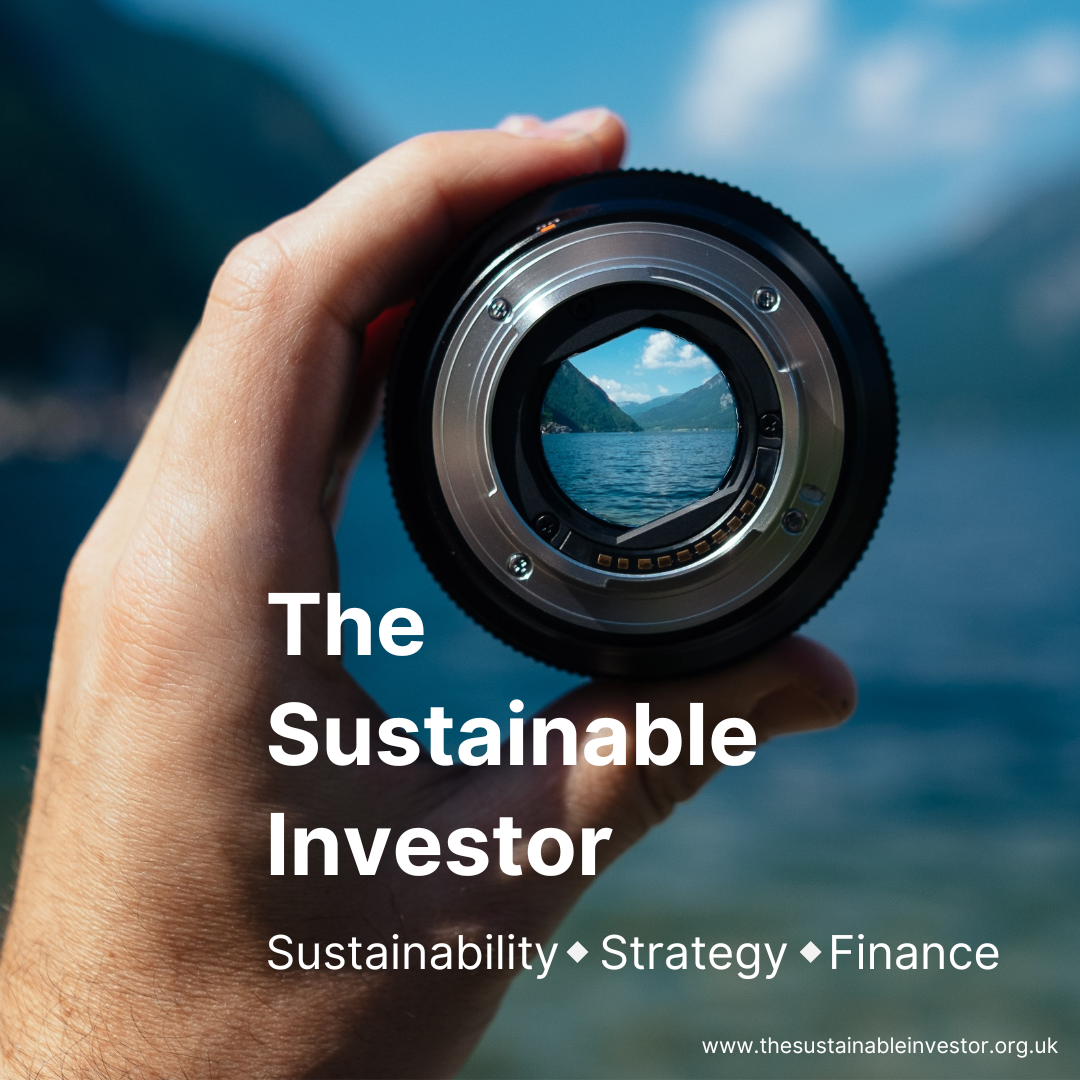
Please read: important legal stuff.


